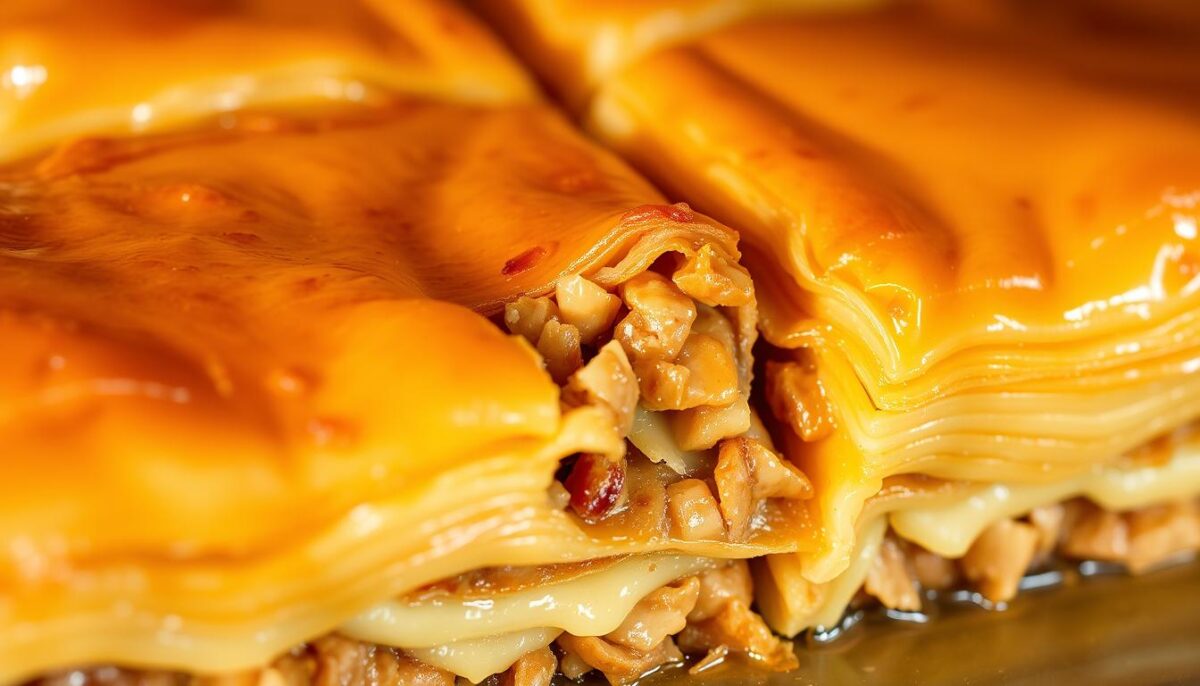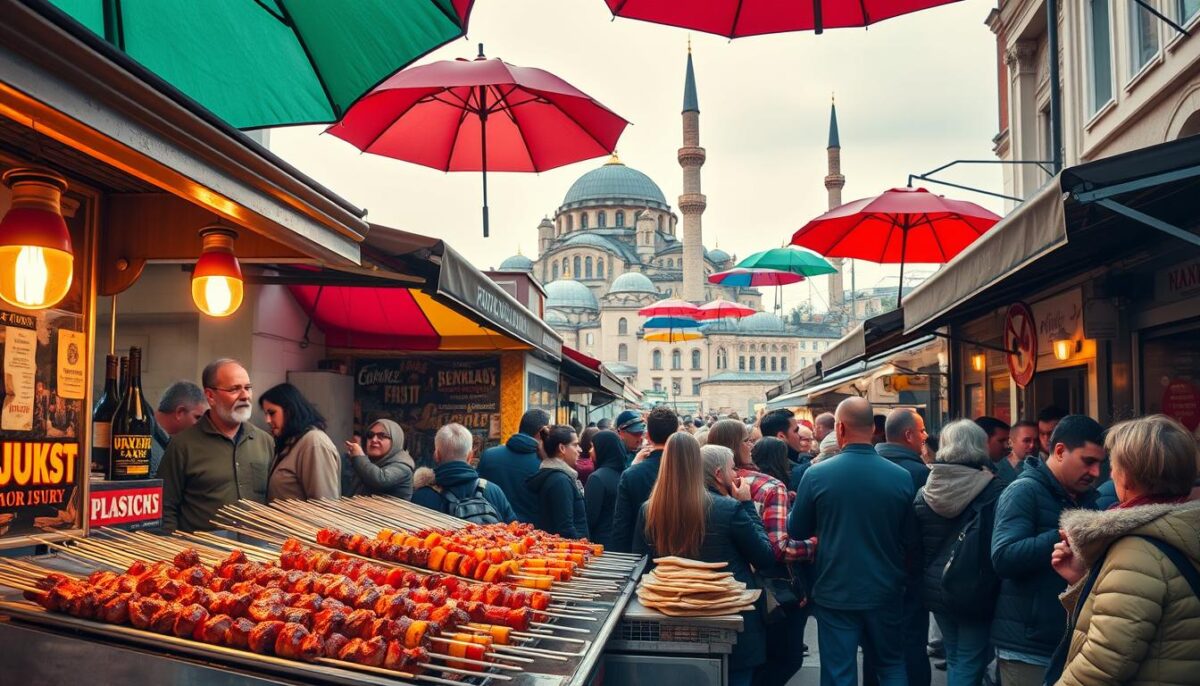
The Ultimate Food Checklist for Your Visit to Kuala Lumpur
June 7, 2025
Where to Go for Late-Night Eats in Las Vegas
June 8, 2025Did you know 87% of travelers rank food experiences as their top priority when exploring new cities? My own culinary journey through bustling markets and fragrant alleyways taught me why. One humid afternoon, I followed the sizzle of grilling meats to a vendor tucked between ancient stone walls. The first bite of his spiced lamb kebap wasn’t just a meal—it was a time machine connecting me to centuries of tradition.
Street eats aren’t just snacks here—they’re cultural artifacts. From golden syrup-drenched pastries to tangy yogurt drinks served in copper cups, every flavor tells a story. Over three trips and countless plates, I’ve mapped the essential bites that define this historic area’s soul.
This guide combines my notebook scribbles, local chefs’ recommendations, and a dash of delicious mistakes. You’ll discover where to find melt-in-your-mouth baklava layered by third-generation masters and why a simple fish sandwich by the water might just change your life. Let’s dive fork-first into the heart of Turkey’s most iconic flavors.
Key Takeaways
- Street food reveals cultural history through bold flavors and time-tested recipes
- Local vendors often serve dishes unchanged for generations
- Balancing sweet and savory creates Istanbul’s signature taste profile
- Early mornings offer the freshest ingredients and shortest lines
- Many iconic snacks cost less than a cup of coffee
- Seasonal variations keep menus exciting year-round
Introduction: My Culinary Journey in Istanbul’s Old Town
Stepping into the maze of cobblestone streets, I felt the city’s heartbeat through sizzling grills and clinking tea glasses. My food-focused trip began at dawn, chasing the scent of freshly baked simit swirling through misty alleys. Three years earlier, a cookbook’s description of Turkish breakfasts planted the seed for this adventure—now I stood where continents collide, notebook in hand.
I mapped my route like a treasure hunt: spice markets before noon, waterfront lunches, and evening sweets where locals queue. Timing proved crucial—arriving at simit bakeries during their golden hours meant flaky perfection, while late-afternoon walks revealed hidden çay bahçesi (tea gardens) perfect for people-watching.
What surprised me most? How breakfast became a cultural compass. Spreads of olives, cheeses, and honey-drenched kaymak taught me to savor mornings Turkish-style. By day three, I’d mastered the art of balancing bitter çay with syrup-soaked pastries—a skill as vital as navigation.
My best tip? Let curiosity override caution. That unmarked stall with grandmothers laughing over dough? It served the creamiest strained yogurt I’ve ever tasted. This guide isn’t just about meals—it’s your key to experiencing the city’s soul, one flavorful bite at a time.
The Rich History Behind Istanbul’s Street Food Culture
Every bite of street food here whispers secrets from Byzantine spice routes and Ottoman kitchens. I once watched a vendor fold minced meat into flatbread using techniques his great-grandfather perfected. “We’re not just feeding stomachs,” he told me, “we’re feeding memories.”
Centuries of global trade shaped these street foods. Sephardic Jewish refugees brought stuffed grape leaves from Spain. Persian traders introduced rice-stuffed mussels popular along ancient routes. Balkan immigrants added yogurt-based sauces still swirling in today’s çılbır. Each wave left flavors that make the city’s culinary DNA a mosaic of influences from around the world.
Walking through busy streets feels like time travel. One stall’s copper pans date to the 1800s, while another uses Instagram to promote lokma donuts. This blend makes every meal a discovery—ancient recipes meeting modern tastes.
My favorite lesson? How scarcity bred creativity. When 16th-century dockworkers couldn’t afford meat, vendors stretched lamb with bulgur wheat—creating the first İçli Köfte. Today’s versions taste richer knowing their humble origins.
“Istanbul’s street cuisine is edible archaeology—each recipe a layer in the city’s story.”
Food historian Dr. Aylin Öney Tan taught me that tasting these foods isn’t just eating—it’s connecting with generations who shaped flavors we still crave.
Istanbul old town dishes: Authentic Street Flavors
Cinnamon and charcoal smoke tangled in the air as I rounded another corner. This labyrinth of flavors reveals its true magic through street food that’s survived empires. My first taste of simit here wasn’t just sesame bread—it was a crunchy portal to generations of bakers perfecting their craft.
What makes these dishes unforgettable? Vendors guard family recipes like state secrets. One cook winked while sprinkling chili flakes on my lentil köfte: “My great-uncle’s ratio—never written down.” Each bite carries this living history, from smoky eggplant dips to citrus-kissed chickpea stews simmering since sunrise.
Mornings bring the freshest adventures. I followed locals to a cart doling out paper cones filled with midye tava—crispy mussels fried to order. The vendor’s lemon wedge twist? “Makes the sea sing louder,” he grinned. That’s the beauty here—even classic recipes get personal flourishes.
“Our streets are the original food network—every stall’s a different channel.”
This guide isn’t just a list—it’s your backstage pass. You’ll discover where walnut-stuffed apricots outshine fancy desserts and why a humble potato roll might upstage your dinner plans. Come hungry: tradition serves seconds here.
Simit: The Iconic Turkish Bread
The crackle of sesame seeds meeting my teeth still echoes in my food memories. My initiation began at a street corner where golden rings spun on metal rods like edible Ferris wheels. This circular bread isn’t just a snack—it’s a cultural handshake.
A Personal Encounter with Simit
My first bite surprised me—crisp exterior giving way to a chewy center, like a bagel’s sophisticated cousin. The vendor dusted flour from his apron as he explained: “Proper simit should sing when you break it.” He wasn’t wrong. That morning’s version, still warm from the oven, paired perfectly with sharp white cheese and tart cherry jam.
What makes it versatile? The ingredients stay simple—flour, water, molasses, sesame—but execution is everything. I learned to spot quality by sound: a hollow tap means ideal air pockets. Locals taught me to treat it as both breakfast centerpiece and afternoon pick-me-up.
Where to Find the Best Simit Stalls
Follow the sesame trails. Top spots cluster near ferry docks and tram stops, where vendors cater to commuters. One cart near Galata Bridge became my daily ritual—their simit stayed crisp even in coastal humidity.
Order like a pro: Point to your preferred ring size (smaller means crunchier). Pair it with:
- Salty beyaz peynir cheese for savory days
- Nutella drizzle when sugar cravings strike
- Ayran yogurt drink for the classic combo
Don’t overlook simit as a side dish either. I once saw a chef crumble it over mussel stew for texture contrast—pure genius. Whether you grab it mid-walk or savor it with tea, this ring-shaped wonder proves why some food traditions never go stale.
Döner: A Classic Meat Feast
The rhythmic scrape of metal against meat still plays in my hunger memories. Picture this: a towering spit of marinated lamb rotating like a carnivorous carousel, its edges crisping to perfection. This isn’t just food—it’s culinary theater where every shave of the knife matters.
Tasting the Juicy Layers
Watching vendors slice paper-thin meat taught me texture alchemy. The outer char gives way to succulent layers that steam in the open air. My first street kebab arrived wrapped in warm flatbread, dripping with garlic sauce and pickled chili. Each bite delivered smoky sweetness from the grill, balanced by tangy toppings.
Street versions spoil you forever. Unlike restaurants serving pre-sliced cuts, carts carve directly from the spit—juices pooling instantly. One vendor’s secret? Brushing the rotating stack with lamb fat every 20 minutes. “Makes it sing,” he said, handing me a sample on a scrap of bread.
Comparing Street and Restaurant Döner
While restaurants offer comfortable seating, their kebab often lacks that crackling edge. Portions shrink, prices double. My favorite street spot near Galata Tower serves lamb-beef blends in portions so generous, they spill from the bread.
Timing matters. Arrive before the lunch rush for the crispiest cuts. Street vendors charge about $3—less than a coffee—for wraps that fuel hours of exploration. Pro tip: Point to the exact section of meat you want. Watching them order taught me locals prefer fatty upper layers for maximum flavor.
“Good döner doesn’t need plates. The best ones drip down your arm.”
Whether you grab it mid-stride or savor it slowly, this kebab embodies Turkish ingenuity. Just bring napkins—the messier your hands, the better the meal.
Pide: Turkey’s Unique Take on Pizza
The scent of charred dough and melted cheese stopped me mid-stride. Before me stretched golden boats of bread cradling rainbow toppings—this was pide, Turkey’s answer to pizza with a personality all its own. My first bite shattered expectations: crackling crust giving way to smoky lamb and caramelized onions.
Shaped like slender canoes, these pastry-adjacent creations balance tradition with modern flair. I sampled versions from street carts to family-run bakeries, each with signature twists. One vendor’s spicy beef blend made my eyes water joyfully, while another’s egg-and-herb topping tasted like sunrise on a plate.
What elevates pide beyond street food? Artisans treat each as a course, not a snack. I watched bakers hand-stretch dough for 20 minutes before adding toppings. “The base must breathe,” explained a fourth-generation maker, sprinkling sesame seeds like confetti.
Surprise MVP? The fruit accompaniments. Tart pomegranate molasses cut through rich meat toppings at one stall. Another served fig compote alongside mint-flecked cheese pide—sweet and savory in perfect harmony.
“Pide is edible architecture—every ingredient has structural purpose.”
For your guide to perfection: Seek out spots where they bake in stone ovens. The best versions balance crispy edges with chewy centers, proving why this bread-based marvel belongs on every food lover’s bucket list.
Kokoreç: The Bold Offal Adventure
The hiss of lamb fat dripping onto coals stopped me cold. Before me spun horizontal spits wrapped in glistening meat ribbons—intestines coiled around sweetbreads like carnous cinnamon rolls. My stomach flipped… then growled louder than the sizzling grill.
“First time?” The vendor grinned, knife flashing as he shaved charred edges into a mountain of crispy bits. I nodded, bracing for gaminess. What hit my tongue instead: peppery warmth hugging smoky lamb, crackling textures playing hopscotch across my palate.
This dish transforms skepticism into devotion. Vendors marinate chopped offal in oregano-red pepper paste overnight, then skewer it tighter than ship ropes. The magic? Slow-turning grills render fat into golden armor while keeping interiors custard-soft.
Here’s the surprise—ingredients that sound challenging create perfect harmony. Tart sumac onions cut through richness. Chili flakes wake up earthy notes. Each paper-wrapped portion comes showered in herbs, demanding messy, joyful eating.
“We don’t hide lamb’s soul—we make it sing louder.”
Street carts prove best for this food adventure. Watch masters rotate spits like clockmakers—too fast burns, too slow dries. Grab yours midday when coals peak. That first bite? A dare becomes an addiction, proving bold meat journeys reward the curious.
Gözleme: The Delicious Stuffed Crepe
Flour dust hung in the air like edible fog as I approached the wooden board. A grandmother’s hands moved like origami masters, folding spinach into paper-thin dough. This wasn’t just food preparation—it was edible geometry perfected over centuries.
What makes gözleme special? Each crepe becomes a canvas for regional flavors. I’ve tasted versions from coastal villages to mountain towns, but the magic happens when fresh ingredients meet hand-stretched pastry.
Flavor Alchemy Unfolded
My favorite combo emerged at a roadside cart: tangy white cheese dancing with fresh mint, hugged by caramelized onions. The vendor’s secret? “Layer herbs under the filling—makes every bite sing.” Crisp edges gave way to steamy centers in perfect contrast.
| Filling | Texture | Best Time |
|---|---|---|
| Spinach & Feta | Crisp & Creamy | Morning |
| Potato & Chive | Pillowy | Afternoon |
| Spiced Meat | Crunchy | Evening |
This dish shines brightest as a breakfast ritual. Early vendors roll dough at sunrise, serving crepes hot enough to melt butter on contact. Pair it with sour cherry jam for sweet-salty harmony that jumpstarts your day.
Watching masters work taught me patience pays. One maker took 15 minutes per crepe, rotating the griddle with ritual precision. The result? A golden pocket of joy proving simple ingredients can create unforgettable meals.
Baklava: Layers of Sweet Indulgence
Crisp layers shattered like edible stained glass under my fork. This pastry masterpiece reveals why Turks call desserts “şekerli mutluluk”—sweet happiness. At a tucked-away shop, I watched a woman layer dough so thin, newspaper print showed through. Her walnut version crunched like autumn leaves dipped in honey.

True artisans treat each baklava as a geometry puzzle. Forty sheets minimum, butter-brushed between phyllo strata. The syrup ratio? “Enough to sweeten memories without drowning them,” explained the shop owner. Pistachio varieties glowed emerald under amber glaze, while hazelnut versions carried earthy depth.
| Type | Nut | Syrup | Texture |
|---|---|---|---|
| Classic | Walnut | Lemon-infused | Crunchy |
| Premium | Pistachio | Rosewater | Flaky |
| Regional | Hazelnut | Orange blossom | Chewy |
Pairing matters. Bitter Turkish coffee cuts through the syrup’s velvet punch. I learned to sip slowly—let the dish’s warmth melt sugar crystals on my tongue. Street vendors serve triangles wrapped in wax paper, perfect for nibbling between sights.
“Baklava measures time in layers—each fold represents generations of patience.”
What surprised me? How accessibility elevates this food art. From posh cafes to alley carts, everyone gets a taste of perfection. That first bite’s crackle followed by syrup surrender? Pure alchemy. Proof that simple bread transformed can conquer the culinary world.
Midye Dolma: The Unexpected Seafood Snack
Twilight transformed the harbor into a symphony of sizzling grills and clinking shells. Between sizzling meat stalls, I spotted a vendor arranging glossy black mussels like edible jewels. Midye dolma defies expectations—cold seafood served street-side, each shell cradling lemon-kissed rice that tastes like coastal breeze made edible.
Vendors prep this dish with surgical precision. They stuff plump mussels with pine nut-studded rice, then chill them until the flavors marry. “The secret?” a cook winked as she drizzled olive oil. “We steam the rice in mussel broth—gives it sea soul.” The shell becomes your spoon, its curve perfect for scraping every herbed grain.
My first bite was a revelation—bright lemon cutting through briny richness, cold texture contrasting warm evening air. Locals taught me the ritual: tilt head back, squeeze citrus, and let the midye dolma slide into your mouth. Messy? Absolutely. Memorable? Unforgettably.
| Size | Rice Type | Price Range |
|---|---|---|
| Small | Plain | $0.50-$1 |
| Medium | Herbed | $1-$1.50 |
| Large | Pine Nut | $1.50-$2 |
Dusk brings the best atmosphere. Vendors display stacked trays glistening under string lights, calling out like seafood sirens. While bigger shells cost more, even budget travelers can feast—six pieces often cost less than a soda.
“We don’t sell food—we sell the Bosphorus in a shell.”
Though unconventional, this dish captures coastal Turkey’s essence. That first cold bite amidst sizzling street stalls? Pure culinary magic that redefines seafood snacking.
Fresh Fruit Juice: Pure Refreshment on the Go
Between sizzling grills and spice stalls, a rainbow of fresh-squeezed nectar stopped me mid-bite. Juice carts glow like edible traffic lights here—blood orange reds, pomegranate rubies, and lime greens cutting through the meat-heavy haze. My first icy cup after a kebab feast felt like hitting reset on my taste buds.
Quality shouts through color. Top vendors stack fruits like edible pyramids—velvety mangoes beside knobbly passion fruits. One Beyoğlu stall owner taught me his trick: “Squeeze pears with lemon peel—adds spark without sugar.” Their mint-kissed watermelon blend became my daily lifeline.
Portions suit every need. Choose shot-sized citrus bursts (₺10) or jumbo pineapple tumblers (₺40). Mornings bring the crispest apple-ginger mixes, while afternoons favor tart pomegranate zingers. Pro tip: Point to fruit piles with condensation beads—they’re freshly prepped.
My favorite finds? A Galata cart serving fig-kiwi fusions, and a Karaköy stand where they layer orange-carrot juice with crushed ice. Both take under a minute to craft—perfect when city exploring melts your energy.
“Our juices are liquid shade trees—cooling you faster than any breeze.”
Time it right: Hit stalls before 11 AM or after 3 PM to skip lunch rushes. That first sip of frosty pomelo? Pure magic proving street food isn’t just about fullness—it’s about revival.
Exploring the Vibrant Streets and Food Stalls
A sudden turn down an unmarked alley revealed steaming cauldrons and laughter—the real heartbeat of this historic area. Navigating these streets feels like solving a delicious puzzle where every corner holds new food revelations. Locals taught me to follow three rules: let your nose lead, embrace wrong turns, and never eat anywhere too quiet.
Navigating the Bustling Districts
Mornings near ferry docks buzz with workers grabbing simit, while afternoons near spice markets tempt with saffron-infused treats. I learned to spot thriving places by their crowd rhythm—steady streams of regulars, not tourist clumps. Top finds often sit between restaurants and residential lanes, where vendors cater to neighbors first.
Finding Authentic Vendors
Look for these signs of quality:
- Handwritten menus with fewer than five items
- Family photos taped to carts or walls
- Ingredients prepped fresh on-site
One kebab master shared his truth: “If your eyes don’t water from the smoke, the meat’s not hot enough.” These streets reward patience—my favorite gözleme spot took three visits before the cook revealed her secret thyme source.
“Real flavors hide where two languages mix—listen for vendors switching between Turkish and Kurdish.”
Daytime exploration unlocks hidden places most guides miss. That unassuming stall with octogenarians debating politics? It served apricot-stuffed lamb that redefined my idea of street food. Remember: the best restaurants here don’t always have chairs—just decades of perfected recipes.
Hidden Gems: Discovering Local Eateries
A faded blue doorway almost hidden by jasmine vines caught my eye—the kind of spot you’d miss if blinking. Inside, a grandmother rolled dough while humming to radio static. Her grandson handed me a cheese-stuffed börek still sizzling from the pan. “Family recipe,” he whispered. “No menus here—we cook what the market gives us.”
These places thrive on whispered recommendations. I found another treasure near a spice warehouse—a four-table restaurant serving garlicky yogurt over charred eggplant. The owner’s twist? Toasted pistachios crushed tableside. “Crunch wakes up the flavors,” she explained, demonstrating with theatrical flair.
Commercial restaurants can’t replicate this magic. Chains use standardized recipes, but these home-style kitchens adapt daily. One cook swapped raisins for pomegranate molasses in stuffed grape leaves after a rainy market day. The result? Tart sweetness that made regulars cheer.
“We don’t follow trends—we follow the seasons and our customers’ moods.”
To order like a local:
- Point to simmering pots—they hold the day’s specials
- Ask “Ne önerirsiniz?” (What do you recommend?)
- Share tables if busy—it often leads to recipe swaps
These places prove the best food stories aren’t on menus—they’re written in shared laughter and unexpected flavor twists.
Insider Tips for Finding the Best Street Food
I learned more about Turkish cuisine from a street vendor’s watch than any guidebook. His cracked timepiece dictated when lamb fat reached caramelization perfection—a lesson in how timing shapes flavor here. Let me share hard-won wisdom for chasing culinary gold.
Timing Your Visit for Maximum Flavor
Dawn delivers magic. Arrive as bakers slide first simit batches from ovens—the sesame crust crackles louder than alarm clocks. Mid-mornings (9-11 AM) let you beat lunch rushes at kebab stands. Watch masters slice meat straight from rotating spits when crowds thin around 3 PM.
Evening explorers face double-edged swords. While sunset grills smoke dramatically, popular spots get swarmed. My trick? Follow office workers streaming off ferries—they know which vendors restock freshest ingredients for dinner service.
“Come when my forehead glistens—that’s when coals burn hottest.”
Three rules for navigating packed streets:
- Walk counter-clockwise around squares to spot hidden carts
- Look for steam plumes rising between buildings
- Time payments—have coins ready during peak hours
Stay flexible. The option you crave at noon might transform into stuffed mussels by dusk. Last Thursday, a gözleme vendor surprised me with wild greens foraged that morning—proof that spontaneity rewards.
Quality clues hide in plain sight. Crowded stalls with locals holding two plates? That’s your cue to join the queue. Remember: the best street food isn’t found—it’s earned through perfect timing and open senses.
Budget-Friendly Bites for the Savvy Foodie
A handful of coins bought my first feast here—proof that culinary magic doesn’t need pricey menus. Street carts offer full meals for under $2, with generous portions rivaling sit-down restaurants. My favorite day involved sampling eight variety items for less than a coffee shop latte.

- Simit rings: 5-10 TL ($0.30-$0.60)
- Döner wraps: 30-50 TL ($1.80-$3)
- Midye dolma: 10-20 TL ($0.60-$1.20) per piece
- Fresh juices: 15-30 TL ($0.90-$1.80) per cup
I mastered the art of order sequencing—grabbing crispy simit for breakfast, then splitting richer food like kokoreç with travel buddies. Lunchtime specials near ferry docks offer complete meals (main + side) for 100 TL ($6). Evening bites cost slightly more, but strategic snacking keeps daily budgets under $15.
“Share plates to taste more—we love seeing visitors try everything!”
Hidden places beyond main streets deliver better value. Follow locals to unmarked stalls near spice warehouses where stuffed grape leaves cost half the tourist-area price. For dessert, family-run carts serve baklava triangles at home-style prices—no velvet ropes required.
Conclusion
My notebook stains tell the real story—honey drips from baklava pages, charcoal smudges from döner stands. Each dish in this historic quarter reveals layers of tradition, from sizzling kebab wraps to syrup-soaked pastry treasures. These flavors don’t just feed—they connect you to centuries of craft.
Planning your trip? Rise early to catch vendors shaping dough at dawn. Seek spots where locals cluster, not menus. That unassuming restaurant with plastic stools? It might serve life-changing stuffed mussels.
This guide blends my best finds—golden simit rings, smoky offal wraps, citrus-kissed seafood—but your journey will uncover new favorites. Share your discoveries online to help others taste the world through these streets.
Hungry explorers: Bring curiosity, not caution. Let grill smoke guide you. Every bite here whispers stories waiting to be savored. Your turn to write the next chapter—one flavorful food memory at a time.
FAQ
What’s the best time of day to explore street food stalls?
I love hitting the streets around lunch or early evening when vendors restock with fresh ingredients. Mornings are perfect for simit and cheese-filled pastries, while evenings bring sizzling kebabs and grilled lamb.
Are there vegetarian-friendly options available?
Absolutely! Try gözleme stuffed with spinach and cheese or pide loaded with veggies. Many stalls customize dishes, so don’t hesitate to ask for no meat. Fresh fruit juices and baklava are sweet plant-based treats.
How do I know if a street vendor is authentic?
Look for spots packed with local crowds—they’re a sure sign. Check if they prepare dishes on-site, like rolling dough for gözleme or grilling meat for döner. Clean stalls and fresh ingredients matter most to me.
What’s the average price for a street food meal?
Most bites cost between
FAQ
What’s the best time of day to explore street food stalls?
I love hitting the streets around lunch or early evening when vendors restock with fresh ingredients. Mornings are perfect for simit and cheese-filled pastries, while evenings bring sizzling kebabs and grilled lamb.
Are there vegetarian-friendly options available?
Absolutely! Try gözleme stuffed with spinach and cheese or pide loaded with veggies. Many stalls customize dishes, so don’t hesitate to ask for no meat. Fresh fruit juices and baklava are sweet plant-based treats.
How do I know if a street vendor is authentic?
Look for spots packed with local crowds—they’re a sure sign. Check if they prepare dishes on-site, like rolling dough for gözleme or grilling meat for döner. Clean stalls and fresh ingredients matter most to me.
What’s the average price for a street food meal?
Most bites cost between $1-5. Simit or midye dolma are under $2, while hearty plates like döner or pide range $3-5. Budget around $10-15 per person for a filling feast with dessert.
Is kokoreç safe for travelers to try?
If you’re adventurous, yes! Reputable vendors clean and season the offal thoroughly. I’d suggest starting with a small portion from a busy stall. Pair it with pickled veggies to balance the rich flavor.
Where can I find the freshest baklava?
Head to family-run shops near historic markets like Karaköy or Kadıköy. I always look for flaky layers and glossy syrup—it’s a sign they make it daily. Grab a box to go for a sweet souvenir!
-5. Simit or midye dolma are under , while hearty plates like döner or pide range -5. Budget around -15 per person for a filling feast with dessert.
Is kokoreç safe for travelers to try?
If you’re adventurous, yes! Reputable vendors clean and season the offal thoroughly. I’d suggest starting with a small portion from a busy stall. Pair it with pickled veggies to balance the rich flavor.
Where can I find the freshest baklava?
Head to family-run shops near historic markets like Karaköy or Kadıköy. I always look for flaky layers and glossy syrup—it’s a sign they make it daily. Grab a box to go for a sweet souvenir!



